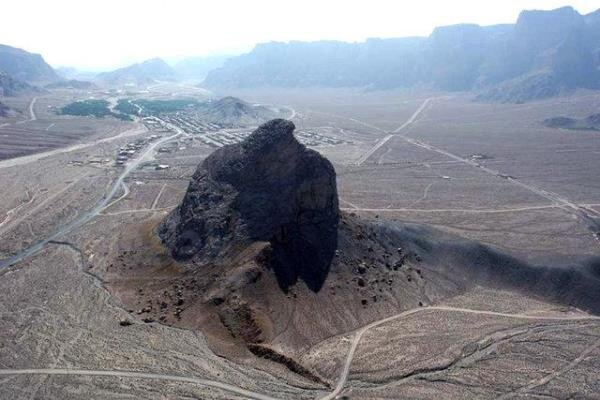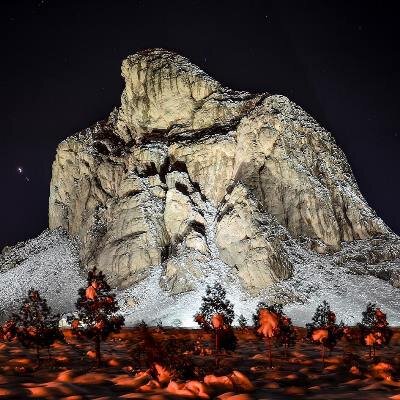
عقابکوه(About Eagle Mountain )
درباره عقابکوه(About Eagle Mountain )
عقابکوه(About Eagle Mountain )
درباره عقابکوه(About Eagle Mountain )آشنایی با عقابکوه یزدGetting to know the Yazd mountain eagle
آشنایی با عقابکوه یزد
Getting to know the Yazd mountain eagle
«عقابکوه» یکی از جالبترین و دیدنیترین کوههای استان یزد است که در شهرستان تفت قرار دارد.

همشهریآنلاین: عقابکوه به صورت یک کوه نسبتا بلند حدود دو هزار متر از سطح دریا ارتفاع دارد. تنها بودن این کوه و زیبایی خیرهکنندهاش همانند یک عقاب در دل کویر، نشان از پادشاهی این کوه در منطقه دارد.
عقابکوه یزد در نزدیکی روستای فراشاه یا اسلامیه واقع شده و منظر طبیعی این کوه به شماره ۳۴۷ در فهرست آثار ملی ایران به ثبت رسیدهاست.
روستای فراشاه که در امتداد محور یزد ـ شیراز و ۳۰ کیلومتری جنوب غربی مرکز استان و ۱۰ کیلومتری شهرستان تفت قرار دارد، از شمال به کوه انجیرایی، از جنوب به کوه سهراب و شیرکوه، از شرق به کوه گلوبادام و از غرب به عقابکوه متصل است.
ارتفاع این روستا از سطح دریا هزار و ۷۶۰ متر است و به دلیل رودخانه فیضآباد که از کنار آبادی میگذرد، آبوهوای آن در فصلهای بهار و پاییز معتدل، در تابستان نسبتاً گرم و در زمستان سرد است.
صعود به قله
قله زیبای عقابکوه در ارتفاع ۱۴۰ متری از سطح روستای فراشاه قرار دارد. برای صعود به قله باید با طی ۱۰ کیلومتر از تفت به سمت این روستا رفت. پس از رسیدن به فراشاه، باید از قسمت غربی روستا به سمت دامنه شمال غربی عقابکوه که شیب کمتری دارد، حرکت کرد .
قدمت عقابکوه را به اوایل دوره دوم زمینشناسی نسبت دادهاند. در اواخر دوره دوم، ساختار بخشهای دیگر کوه تغییر کرد و ارتفاع بیشتری به خود گرفت. در دوره چهارم زمینشناسی، بافت آهکی عقاب کوه یزد به خاطر افت دما، یخ بندان شدید و سپس ذوب شدن آن، به شدت دچار فرسایش شیمیایی و مکانیکی شد.
فرسایش کوه
متفاوت بودن جنس سنگهای اطراف کوه و فرآیندهای فرسایشی آبی و بادی باعث تشکیل عقابکوه شده است. کوههای بلند انجیرایی، سهراب و شیرکوه که اطراف این کوه را گرفتهاند، یک تونل باد را به وجود آوردهاند که همراه باد و باران باعث ایجاد این شکل دیدنی شدهاند.
به علت فرسایش و آهکی بودن جنس کوه، هیچ گیاه و چشمهای بر روی آن وجود ندارد. حفرههای بسیاری در قسمت فوقانی به چشم میخورد که جانوران از آن به عنوان لانه استفاده میکنند.
توده گرانیتی در غرب عقابکوه، این تشکیلات آهکی را به سمت بالا آورده و حتی باعث دگرگونی بعضی قسمتهای زیرین کوه نیز شده است.
خطرات طبیعی و انسانی
فرسایش همانطور که موجب شکلگیری چنین جاذبهای شده، در حال حاضر نیز به آن صدمه وارد کرده است. وجود سنگها و حفرههای بزرگ و کوچک که در دامنه کوه هستند، نشان از همین فرسایش دارد.
بومیان معتقدند که بدنه عقابکوه در طی سالهای اخیر دچار تغییر و تکههایی از آن نیز جدا شدهاست.

Acquaintance with Eagle Mountain, Yazd Getting to know the Yazd mountain eagle "Eagle Mountain" is one of the most interesting and spectacular mountains in Yazd province, located in Taft city. mountain eagle Hamshahri Online: Aqabkoh is a relatively high mountain about two thousand meters above sea level. The solitude of this mountain and its stunning beauty, like an eagle in the heart of the desert, shows the kingship of this mountain in the region. Eagle Mountain of Yazd is located near the village of Farashah or Islamia and the natural landscape of this mountain is registered as number 347 in the list of national monuments of Iran. Farashah village, which is located along the Yazd-Shiraz axis and 30 kilometers southwest of the provincial capital and 10 kilometers from Taft city, is connected to Anjirai mountain from the north, Sohrab and Shirkoh mountains from the south, Globadam mountain from the east, and Aqab mountain from the west. . The height of this village is 1,760 meters above sea level, and because of the Faizabad River that passes by the village, its weather is mild in spring and autumn, relatively hot in summer and cold in winter. Climb to peak The beautiful peak of Aqabkoh is located at a height of 140 meters above the level of Farashah village. To climb to the peak, you have to walk 10 kilometers from Taft to this village. After reaching Farshah, one should move from the western part of the village to the northwestern slope of Aqabkoh, which has a lower slope. The age of Eagle Mountain has been attributed to the beginning of the second geological period. At the end of the second period, the structure of other parts of the mountain changed and gained more height. In the fourth geological period, the calcareous texture of Yazd Mountain Eagle suffered severe chemical and mechanical erosion due to temperature drop, severe freezing and then melting. Mountain erosion Different types of rocks around the mountain and water and wind erosion processes have caused the formation of Eagle Mountain. The high mountains of Anjirai, Sohrab and Shirkoh, which surround this mountain, have created a wind tunnel, which together with the wind and rain have created this spectacular shape. Due to the erosion and limestone nature of the mountain, there are no plants or springs on it. Many holes can be seen in the upper part, which animals use as nests. The granite mass in the west of Aqab Kouh has brought this limestone formation upwards and has even caused the transformation of some lower parts of the mountain. Natural and human hazards Erosion, just as it caused the formation of such an attraction, has also harmed it now. The presence of small and large rocks and holes on the mountain slopes is a sign of this erosion. The natives believe that the body of Eagle Mountain has undergone changes in recent years and pieces have been separated from it.
درباره عقابکوهAbout Eagle Mountain
درباره عقابکوهعقاب کوه در 1.5 کیلومتری شرق روستای اسلامیه، در نزدیکی شهرستان تفت، در استان یزد بر سر راه شیراز به یزد، در مرکز ایران جای دارد. استان یزد در نقطه اتصال دشت کویر و کویر لوت جای دارد. اینجا سرزمین کویرهای باستانی، تپههای ماسهای، سنگفرشهای بیابانی، کوهریگها، درهها، غارها و سنگآبهای آهکی، کلوتها و بسیاری از جاذبههای گردشگری در میانه فلات ایران است. در این میان چشم رهگذران و مسافران به سوی نمای سنگی یک کوه که مانند عقابی نشسته است، پرواز میکند.
عقاب کوه یادگاری از دوران دوم زمینشناختی ایران است که به 200 میلیون سال پیش باز میگردد. هرچند یک توده سنگ آذرین در دامنه شمالی شیر کوه تاثیر ویژهای بر پیدایش فرم عقاب کوه گذاشته است و وزش بادها نیز در طول تاریخ به ویژه از سوی «کوه بادآسمان» از شمال نیز در پیدایش نمای عقابی این کوه نقش داشته است.
عقاب کوه که از سال 1396 خورشیدی یکی از آثار ملی ایران است، در کنار روستای «فراشاه»، که «اسلامیه» خوانده میشود، جای دارد. روستای اسلامیه در دامنه شمالی شیرکوه و کنار عقاب کوه، در 10 کیلومتری تفت و در 30 کیلومتری شهر یزد جای گرفته است. مردمان این روستای گردشگری به دامداری و کشاورزی و باغداری میپردازند.
اگرچه عقاب کوه 2018متر از تراز دریا بالاتر است اما ارتفاع صخره اصلی حدود 140 متر است. این صخره زیبا با جنسی از آهک و سنگ گارنیت از دل زمین رسته است. بارش باران و نفوذ آب در ساختار آهکی کوه، به پدید آمدن روزنههایی در آن انجامیده و پناهگاه گونههایی از حیات وحش نیز شده است. از طرفی همین آهکی بودن جنس سنگ، از رویش گیاهان بر پیکر کوه جلوگیری کرده است.
دامنه شمال غرب عقاب کوه برای فرود به قله، از شیب کمتری برخوردار است. بلندی این کوه در دشت و وکویر برای برگزاری آیین، به پیدایش نشانههای تاریخی مانند موبدان فیروز از دوران شاهنشاهی اشکانی و نیز برج دیدبانی «چیل اسلامیه» در پیرامون عقاب کوه انجامیده است.
چشمه تامهر در 13 کیلومتری شرق عقاب کوه و غار اسلامیه نیز در 30 کیلومتری این نماد ایرانی جای دارد. از دیگر جاذبههای گردشگری نزدیک عقاب کوه میتوان آبشارهای درگاهان و لوسو، برفخانه طرزجان، ییلاقهای سانیچ و نیر و بیداخوید و سخوید و زردین، باغستانها و نخلستانها و انارستانها، غار بادامستان، دژ اسلامیه، درب کهت، آسیاب آبی اسلامیه، پیر چک چک و نیز چنار 1500 ساله مسجد قدمگاه را نام برد.
About Eagle Mountain Eagle Mountain is located 1.5 kilometers east of Islamiyah village, near Taft city, in Yazd province, on the way from Shiraz to Yazd, in the center of Iran. Yazd province is located at the junction of Dasht Kavir and Kavir Lot desert. This is the land of ancient deserts, sand hills, desert pavements, gorges, valleys, caves and limestone caves, klots and many tourist attractions in the middle of the Iranian plateau. In the meantime, the eyes of passers-by and travelers fly towards the stone facade of a mountain that sits like an eagle. Eagle Mountain is a relic of Iran's second geological period, which dates back to 200 million years ago. However, a mass of igneous rock on the northern slope of Shir Kouh has had a special effect on the formation of the eagle shape of the mountain, and the winds throughout history, especially from the "Mountain of the Sky" from the north, have also played a role in the formation of the eagle face of this mountain. The mountain eagle, which has been one of the national monuments of Iran since 2016, is located next to the village of "Farashah", which is called "Islamiyeh". Islamiya village is located on the northern slope of Shirkuh and next to Aqab Mountain, 10 km from Taft and 30 km from Yazd city. The people of this tourist village are engaged in animal husbandry, agriculture and horticulture. Although Eagle Mountain is 2018 meters above sea level, the height of the main rock is about 140 meters. This beautiful rock is made of limestone and garnet stone from the heart of the earth. Rainfall and water infiltration in the limestone structure of the mountain has led to the emergence of openings in it and has become a shelter for species of wildlife. On the other hand, the calcareous nature of the rock has prevented plants from growing on the mountain. The northwest slope of Aqab Mountain has a lower slope for descending to the peak. The height of this mountain in the plains and deserts has led to the emergence of historical landmarks such as Mobdan Firouz from the Parthian Empire era and the observation tower "Chil Islamiyah" around the eagle mountain. Tamher Spring is located 13 kilometers east of Eagle Mountain and Islamiyah Cave is located 30 kilometers from this Iranian symbol. Other tourist attractions near Aqab Mountain include Dargahan and Luso waterfalls, Tarzjan Ice Creamery, Sanich and Nair summerhouses, Bidakhoid, Sakhoid and Zardin, gardens, palm groves and pomegranate groves, Badamestan Cave, Islamiye Fort, Kohet Gate, Islamiciye Water Mill, Pir Chek Chek and He also named the 1500-year-old sycamore of Gadhamgah Mosque.